Activated Carbons for Arsenic Removal from Natural Waters and Wastewaters: A Review
Abstract
:1. Introduction
2. Methodology
3. Synthesis of the Materials
4. Characterizations
5. Adsorption Evaluation
5.1. Effect of pH
5.2. Kinetic Studies
5.3. Isotherms and Effect of Temperature
5.4. Effect of Temperature on Arsenic Adsorption by Activated Carbons
6. Regeneration
7. Conclusions and Perspectives
Author Contributions
Funding
Data Availability Statement
Conflicts of Interest
References
- Nations, U. World Water Development Report 2018, Nature Based Solutions for Water. Available online: http://www.unwater.org/publications/world-water-development-report-2018 (accessed on 23 January 2019).
- Murcott, S. Arsenic Contamination in the World—An International Sourcebook; IWA Publishing: London, UK, 2012. [Google Scholar]
- Hering, J.G.; Katsoyiannis, I.A.; Theoduloz, G.A.; Berg, M.; Hug, S.J. Arsenic Removal from Drinking Water: Experiences with Technologies and Constraints in Practice. J. Environ. Eng. 2017, 143, 03117002. [Google Scholar] [CrossRef]
- Podgorski, J.E.; Eqani, S.A.M.A.S.; Khanam, T.; Ullah, R.; Shen, H.; Berg, M. Extensive arsenic contamination in high-pH unconfined aquifers in the Indus Valley. Sci. Adv. 2017, 3, e1700935. [Google Scholar] [CrossRef] [PubMed] [Green Version]
- Katsoyiannis, I.A.; Mitrakas, M.; Zouboulis, A.I. Arsenic occurrence in Europe: Emphasis in Greece and description of the applied full-scale treatment plants. Desalination Water Treat. 2015, 54, 2100–2107. [Google Scholar] [CrossRef]
- Mohanty, D. Conventional as well as Emerging Arsenic Removal Technologies—A Critical Review. Water Air Soil Pollut. 2017, 228, 381. [Google Scholar] [CrossRef]
- World Health Organization. Arsenic in Drinking Water. 2001. Available online: http://www.who.int/inffs/en/fact210.html (accessed on 12 September 2021).
- Khan, A.H.; Rasul, S.B.; Munir, A.K.M.; Habibuddowla, M.; Alauddin, M.; Newaz, S.S.; Hussam, A. Appraisal of a simple arsenic removal method for ground water of Bangladesh. J. Environ. Sci. Health Part A 2000, 35, 1021–1041. [Google Scholar] [CrossRef]
- Arsenic Contamination in Ground Water in India. Available online: https://vikaspedia.in/energy/environment/know-your-environment/water/arsenic-contamination-in-ground-water-in-india (accessed on 12 September 2021).
- Phok, R.; Nandalal, K.D.W.; Pitawala, H.M.T.G.; Dharmagunawardhane, H.; Weerakoon, S. Arsenic Contamination in Cambodia: A Status Review. 2018. Available online: https://www.academia.edu/34037120/Arsenic_Contamination_in_Cambodia (accessed on 12 September 2021).
- Kim, M.-J.; Ahn, K.-H.; Jung, Y. Distribution of inorganic arsenic species in mine tailings of abandoned mines from Korea. Chemosphere 2002, 49, 307–312. [Google Scholar] [CrossRef]
- Smedley, P.L.; Kinniburgh, D.G. A review of the source, behaviour and distribution of arsenic in natural waters. Appl. Geochem. 2002, 17, 517–568. [Google Scholar] [CrossRef] [Green Version]
- Mandal, B.K.; Suzuki, K.T. Arsenic round the world: A review. Talanta 2002, 58, 201–235. [Google Scholar] [CrossRef]
- Ungureanu, G.; Santos, S.; Boaventura, R.; Botelho, C. Arsenic and antimony in water and wastewater: Overview of removal techniques with special reference to latest advances in adsorption. J. Environ. Manag. 2015, 151, 326–342. [Google Scholar] [CrossRef]
- Issa, N.B.; Rajaković-Ognjanović, V.N.; Marinković, A.D.; Rajaković, L.V. Separation and determination of arsenic species in water by selective exchange and hybrid resins. Anal. Chim. Acta 2011, 706, 191–198. [Google Scholar] [CrossRef]
- Larios, R.; Fernández-Martínez, R.; LeHecho, I.; Rucandio, I. A methodological approach to evaluate arsenic speciation and bioaccumulation in different plant species from two highly polluted mining areas. Sci. Total Environ. 2012, 414, 600–607. [Google Scholar] [CrossRef]
- Smith, A.H.; Marshall, G.; Yuan, Y.; Ferreccio, C.; Liaw, J.; Ehrenstein, O.V.; Steinmaus, C.; Bates, M.N.; Selvin, S. Increased Mortality from Lung Cancer and Bronchiectasis in Young Adults after Exposure to Arsenic in Uteroand in Early Childhood. Environ. Health Perspect. 2006, 114, 1293–1296. [Google Scholar] [CrossRef] [Green Version]
- Gu, Z.; Fang, J.; Deng, B. Preparation and Evaluation of GAC-Based Iron-Containing Adsorbents for Arsenic Removal. Environ. Sci. Technol. 2005, 39, 3833–3843. [Google Scholar] [CrossRef]
- Vitela-Rodriguez, A.V.; Rangel-Mendez, J.R. Arsenic removal by modified activated carbons with iron hydro(oxide) nanoparticles. J. Environ. Manag. 2013, 114, 225–231. [Google Scholar] [CrossRef]
- Muñiz, G.; Fierro, V.; Celzard, A.; Furdin, G.; Gonzalez-Sánchez, G.; Ballinas, M.L. Synthesis, characterization and performance in arsenic removal of iron-doped activated carbons prepared by impregnation with Fe(III) and Fe(II). J. Hazard. Mater. 2009, 165, 893–902. [Google Scholar] [CrossRef]
- Chen, W.; Parette, R.; Zou, J.; Cannon, F.S.; Dempsey, B.A. Arsenic removal by iron-modified activated carbon. Water Res. 2007, 41, 1851–1858. [Google Scholar] [CrossRef] [PubMed]
- Mondal, M.K.; Garg, R. A comprehensive review on removal of arsenic using activated carbon prepared from easily available waste materials. Environ. Sci. Pollut. Res. 2017, 24, 13295–13306. [Google Scholar] [CrossRef]
- Xiong, Y.; Tong, Q.; Shan, W.; Xing, Z.; Wang, Y.; Wen, S.; Lou, Z. Arsenic transformation and adsorption by iron hydroxide/manganese dioxide doped straw activated carbon. Appl. Surf. Sci. 2017, 416, 618–627. [Google Scholar] [CrossRef]
- Kalaruban, M.; Loganathan, P.; Nguyen, T.V.; Nur, T.; Hasan Johir, M.A.; Nguyen, T.H.; Trinh, M.V.; Vigneswaran, S. Iron-impregnated granular activated carbon for arsenic removal: Application to practical column filters. J. Environ. Manag. 2019, 239, 235–243. [Google Scholar] [CrossRef] [PubMed]
- Velazquez-Jimenez, L.H.; Arcibar-Orozco, J.A.; Rangel-Mendez, J.R. Overview of As(V) adsorption on Zr-functionalized activated carbon for aqueous streams remediation. J. Environ. Manag. 2018, 212, 121–130. [Google Scholar] [CrossRef] [PubMed]
- Liu, Z.; Zhang, F.-S.; Sasai, R. Arsenate removal from water using Fe3O4-loaded activated carbon prepared from waste biomass. Chem. Eng. J. 2010, 160, 57–62. [Google Scholar] [CrossRef]
- Ryu, S.-R.; Jeon, E.-K.; Yang, J.-S.; Baek, K. Adsorption of As(III) and As(V) in groundwater by Fe–Mn binary oxide-impregnated granular activated carbon (IMIGAC). J. Taiwan Inst. Chem. Eng. 2017, 72, 62–69. [Google Scholar] [CrossRef]
- Gong, X.-J.; Li, Y.-S.; Dong, Y.-Q.; Li, W.-G. Arsenic adsorption by innovative iron/calcium in-situ-impregnated mesoporous activated carbons from low-temperature water and effects of the presence of humic acids. Chemosphere 2020, 250, 126275. [Google Scholar] [CrossRef]
- Nieto-Delgado, C.; Gutiérrez-Martínez, J.; Rangel-Méndez, J.R. Modified activated carbon with interconnected fibrils of iron-oxyhydroxides using Mn2+ as morphology regulator, for a superior arsenic removal from water. J. Environ. Sci. 2019, 76, 403–414. [Google Scholar] [CrossRef]
- Wang, H.; Cui, L.-F.; Yang, Y.; Sanchez Casalongue, H.; Robinson, J.T.; Liang, Y.; Cui, Y.; Dai, H. Mn3O4−Graphene Hybrid as a High-Capacity Anode Material for Lithium Ion Batteries. J. Am. Chem. Soc. 2010, 132, 13978–13980. [Google Scholar] [CrossRef] [Green Version]
- Mondal, P.; Majumder, C.B.; Mohanty, B. Laboratory based approaches for arsenic remediation from contaminated water: Recent developments. J. Hazard. Mater. 2006, 137, 464–479. [Google Scholar] [CrossRef] [PubMed]
- Chandra, V.; Park, J.; Chun, Y.; Lee, J.W.; Hwang, I.-C.; Kim, K.S. Water-Dispersible Magnetite-Reduced Graphene Oxide Composites for Arsenic Removal. ACS Nano 2010, 4, 3979–3986. [Google Scholar] [CrossRef] [PubMed]
- Wen, Z.; Zhang, Y.; Dai, C.; Chen, B.; Guo, S.; Yu, H.; Wu, D. Synthesis of ordered mesoporous iron manganese bimetal oxides for arsenic removal from aqueous solutions. Microporous Mesoporous Mater. 2014, 200, 235–244. [Google Scholar] [CrossRef]
- Liu, X.; Ao, H.; Xiong, X.; Xiao, J.; Liu, J. Arsenic Removal from Water by Iron-Modified Bamboo Charcoal. Water Air Soil Pollut. 2012, 223, 1033–1044. [Google Scholar] [CrossRef]
- Guo, Y.; Rockstraw, D.A. Physicochemical properties of carbons prepared from pecan shell by phosphoric acid activation. Bioresour. Technol. 2007, 98, 1513–1521. [Google Scholar] [CrossRef]
- Namduri, H.; Nasrazadani, S. Quantitative analysis of iron oxides using Fourier transform infrared spectrophotometry. Corros. Sci. 2008, 50, 2493–2497. [Google Scholar] [CrossRef]
- Karagöz, S.; Tay, T.; Ucar, S.; Erdem, M. Activated carbons from waste biomass by sulfuric acid activation and their use on methylene blue adsorption. Bioresour. Technol. 2008, 99, 6214–6222. [Google Scholar] [CrossRef] [PubMed]
- Sricharoenchaikul, V.; Pechyen, C.; Aht-ong, D.; Atong, D. Preparation and Characterization of Activated Carbon from the Pyrolysis of Physic Nut (Jatropha curcas L.) Waste. Energy Fuels 2008, 22, 31–37. [Google Scholar] [CrossRef]
- Hashim, M.A.; Kundu, A.; Mukherjee, S.; Ng, Y.-S.; Mukhopadhyay, S.; Redzwan, G.; Sen Gupta, B. Arsenic removal by adsorption on activated carbon in a rotating packed bed. J. Water Process Eng. 2019, 30, 100591. [Google Scholar] [CrossRef]
- Shu, J.; Cheng, S.; Xia, H.; Zhang, L.; Peng, J.; Li, C.; Zhang, S. Copper loaded on activated carbon as an efficient adsorbent for removal of methylene blue. RSC Adv. 2017, 7, 14395–14405. [Google Scholar] [CrossRef] [Green Version]
- Khalili, N.R.; Campbell, M.; Sandi, G.; Golaś, J. Production of micro- and mesoporous activated carbon from paper mill sludge: I. Effect of zinc chloride activation. Carbon 2000, 38, 1905–1915. [Google Scholar] [CrossRef]
- Hu, Z.-P.; Gao, Z.-M.; Liu, X.; Yuan, Z.-Y. High-surface-area activated red mud for efficient removal of methylene blue from wastewater. Adsorpt. Sci. Technol. 2018, 36, 62–79. [Google Scholar] [CrossRef]
- Budinova, T.; Savova, D.; Tsyntsarski, B.; Ania, C.O.; Cabal, B.; Parra, J.B.; Petrov, N. Biomass waste-derived activated carbon for the removal of arsenic and manganese ions from aqueous solutions. Appl. Surf. Sci. 2009, 255, 4650–4657. [Google Scholar] [CrossRef] [Green Version]
- Tuna, A.Ö.A.; Özdemir, E.; Şimşek, E.B.; Beker, U. Removal of As(V) from aqueous solution by activated carbon-based hybrid adsorbents: Impact of experimental conditions. Chem. Eng. J. 2013, 223, 116–128. [Google Scholar] [CrossRef]
- Zhang, F.S.; Itoh, H. Iron oxide-loaded slag for arsenic removal from aqueous system. Chemosphere 2005, 60, 319–325. [Google Scholar] [CrossRef]
- Wang, Y.; Liu, H.; Wang, S.; Li, X.; Wang, X.; Jia, Y. Simultaneous removal and oxidation of arsenic from water by δ-MnO2 modified activated carbon. J. Environ. Sci. 2020, 94, 147–160. [Google Scholar] [CrossRef]
- Yadava, V.; Tiwaria, D.; Bhagata, M.J.D.; TREATMENT, W. Isotherm, kinetics and thermodynamic parameters study of arsenic (III) and copper (II) adsorption onto Limonia acidissima shell carbon. Desalination Water Treat. 2020, 184, 214–224. [Google Scholar] [CrossRef]
- Koohzad, E.; Jafari, D.; Esmaeili, H. Adsorption of Lead and Arsenic Ions from Aqueous Solution by Activated Carbon Prepared from Tamarix Leaves. ChemistrySelect 2019, 4, 12356–12367. [Google Scholar] [CrossRef]
- Pawar, R.R.; Kim, M.; Kim, J.-G.; Hong, S.-M.; Sawant, S.Y.; Lee, S.M. Efficient removal of hazardous lead, cadmium, and arsenic from aqueous environment by iron oxide modified clay-activated carbon composite beads. Appl. Clay Sci. 2018, 162, 339–350. [Google Scholar] [CrossRef]
- Kumar, D.; Gaur, J.P. Chemical reaction- and particle diffusion-based kinetic modeling of metal biosorption by a Phormidium sp.-dominated cyanobacterial mat. Bioresour. Technol. 2011, 102, 633–640. [Google Scholar] [CrossRef] [PubMed]
- Ho, Y.-S. Review of second-order models for adsorption systems. J. Hazard. Mater. 2006, 136, 681–689. [Google Scholar] [CrossRef] [PubMed] [Green Version]
- Zhu, J.; Baig, S.A.; Sheng, T.; Lou, Z.; Wang, Z.; Xu, X. Fe3O4 and MnO2 assembled on honeycomb briquette cinders (HBC) for arsenic removal from aqueous solutions. J. Hazard. Mater. 2015, 286, 220–228. [Google Scholar] [CrossRef] [PubMed]
- Luo, X.; Wang, C.; Luo, S.; Dong, R.; Tu, X.; Zeng, G. Adsorption of As (III) and As (V) from water using magnetite Fe3O4-reduced graphite oxide–MnO2 nanocomposites. Chem. Eng. J. 2012, 187, 45–52. [Google Scholar] [CrossRef]
- Cooper, A.M.; Hristovski, K.D.; Möller, T.; Westerhoff, P.; Sylvester, P. The effect of carbon type on arsenic and trichloroethylene removal capabilities of iron (hydr)oxide nanoparticle-impregnated granulated activated carbons. J. Hazard. Mater. 2010, 183, 381–388. [Google Scholar] [CrossRef] [PubMed]
- Ociński, D.; Jacukowicz-Sobala, I.; Mazur, P.; Raczyk, J.; Kociołek-Balawejder, E. Water treatment residuals containing iron and manganese oxides for arsenic removal from water—Characterization of physicochemical properties and adsorption studies. Chem. Eng. J. 2016, 294, 210–221. [Google Scholar] [CrossRef]
- Karmacharya, M.S.; Gupta, V.K.; Tyagi, I.; Agarwal, S.; Jha, V.K. Removal of As(III) and As(V) using rubber tire derived activated carbon modified with alumina composite. J. Mol. Liq. 2016, 216, 836–844. [Google Scholar] [CrossRef]
- Wang, C.; Luo, H.; Zhang, Z.; Wu, Y.; Zhang, J.; Chen, S. Removal of As(III) and As(V) from aqueous solutions using nanoscale zero valent iron-reduced graphite oxide modified composites. J. Hazard. Mater. 2014, 268, 124–131. [Google Scholar] [CrossRef]
- Gu, Z.; Deng, B.; Yang, J. Synthesis and evaluation of iron-containing ordered mesoporous carbon (FeOMC) for arsenic adsorption. Microporous Mesoporous Mater. 2007, 102, 265–273. [Google Scholar] [CrossRef]
- Shih, Y.-J.; Huang, R.-L.; Huang, Y.-H. Adsorptive removal of arsenic using a novel akhtenskite coated waste goethite. J. Clean. Prod. 2015, 87, 897–905. [Google Scholar] [CrossRef]
- Rusmin, R.; Sarkar, B.; Liu, Y.; McClure, S.; Naidu, R. Structural evolution of chitosan–palygorskite composites and removal of aqueous lead by composite beads. Appl. Surf. Sci. 2015, 353, 363–375. [Google Scholar] [CrossRef]
- Yao, S.; Liu, Z.; Shi, Z. Arsenic removal from aqueous solutions by adsorption onto iron oxide/activated carbon magnetic composite. J. Environ. Health Sci. Eng. 2014, 12, 58. [Google Scholar] [CrossRef] [Green Version]
- Biswas, B.K.; Inoue, J.-I.; Inoue, K.; Ghimire, K.N.; Harada, H.; Ohto, K.; Kawakita, H. Adsorptive removal of As(V) and As(III) from water by a Zr(IV)-loaded orange waste gel. J. Hazard. Mater. 2008, 154, 1066–1074. [Google Scholar] [CrossRef]
- Sandoval, R.; Cooper, A.M.; Aymar, K.; Jain, A.; Hristovski, K. Removal of arsenic and methylene blue from water by granular activated carbon media impregnated with zirconium dioxide nanoparticles. J. Hazard. Mater. 2011, 193, 296–303. [Google Scholar] [CrossRef]
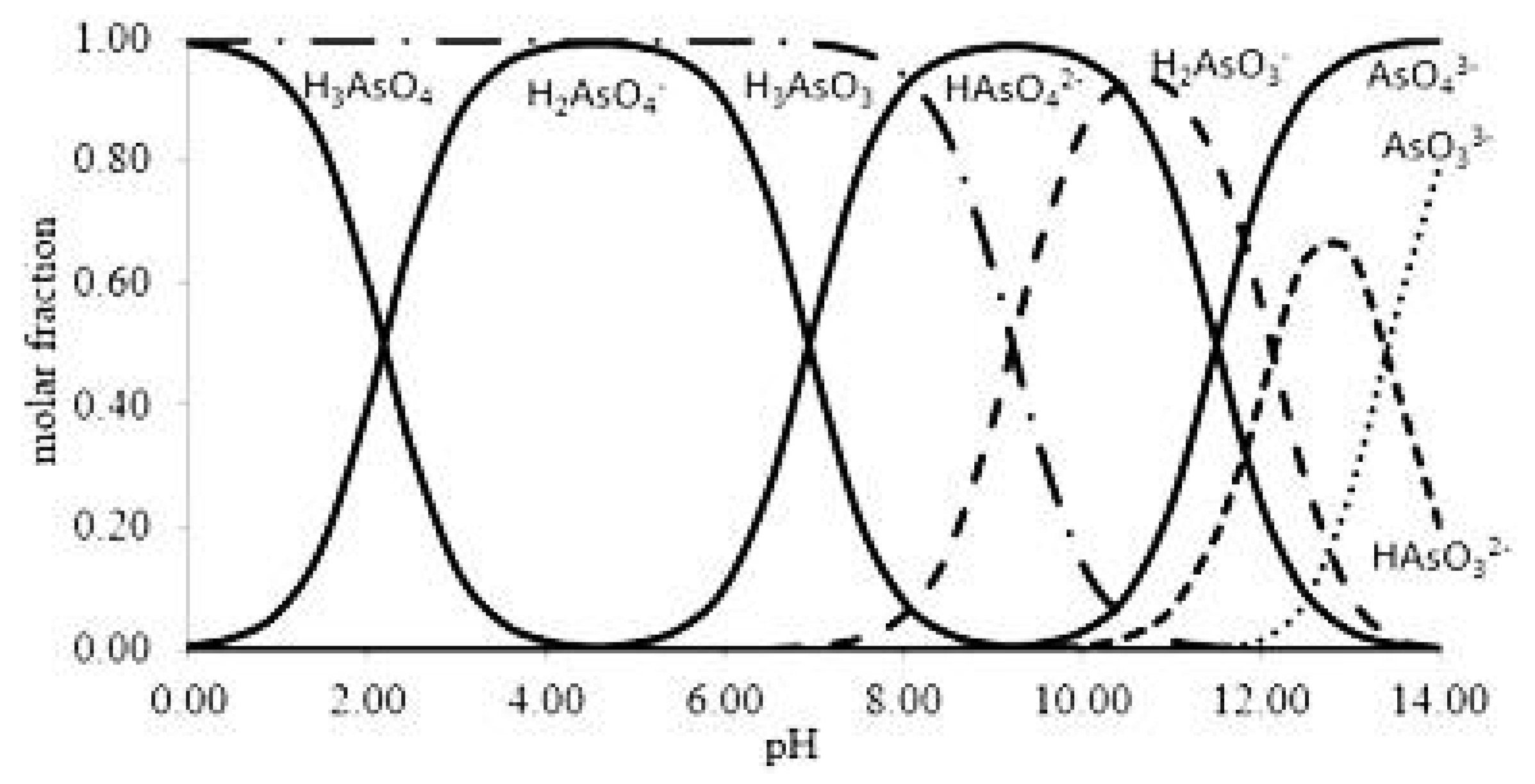

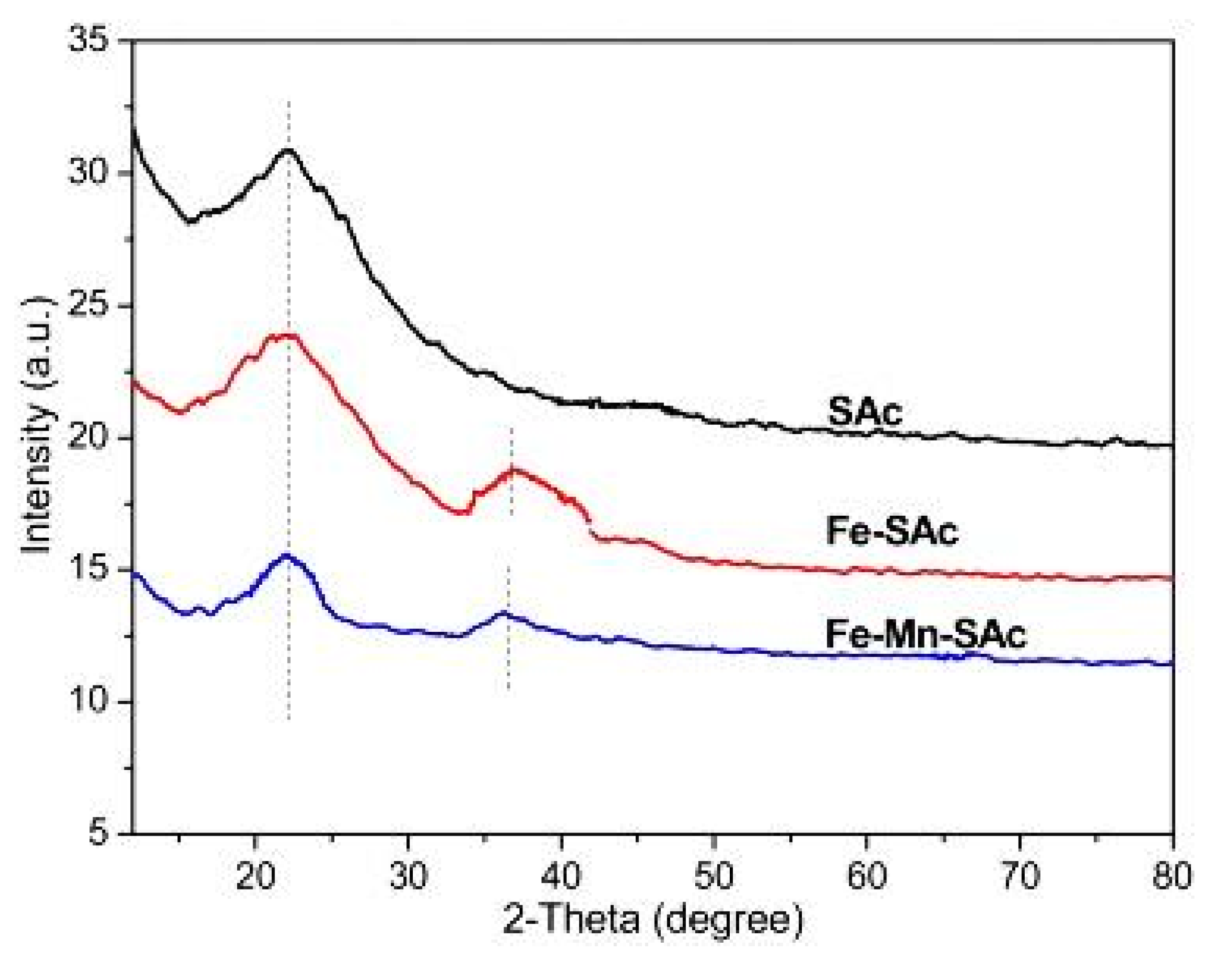
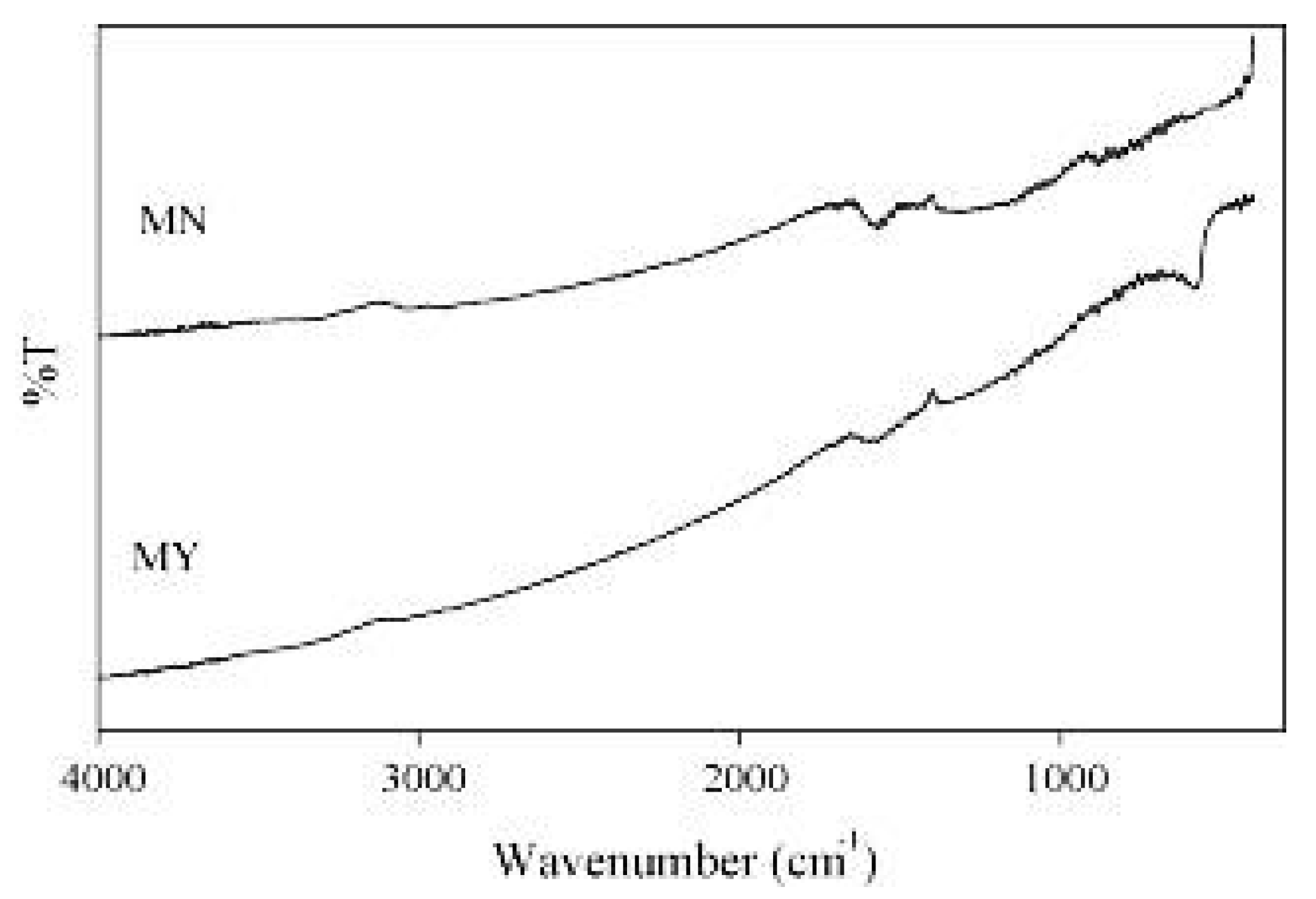
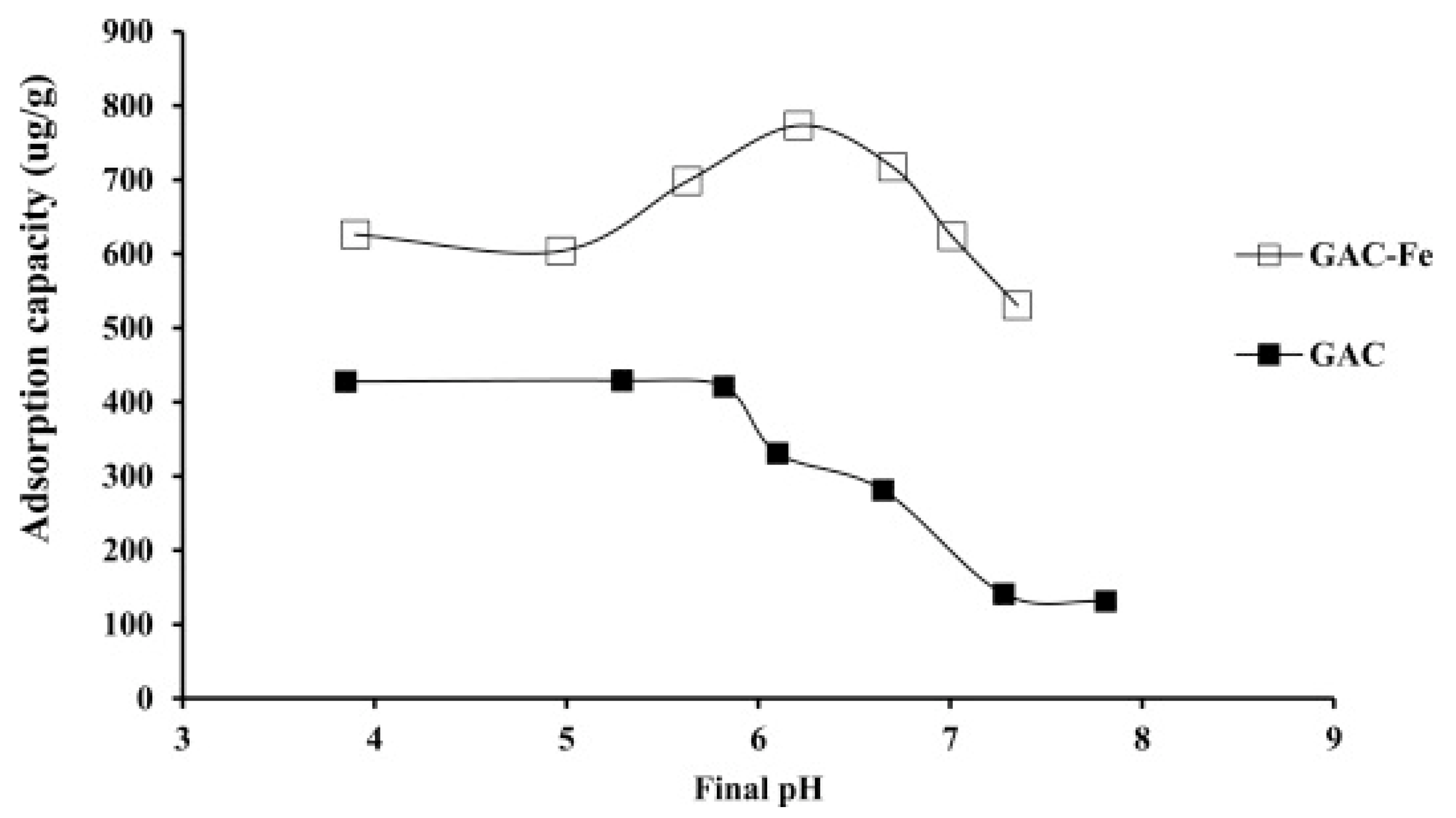
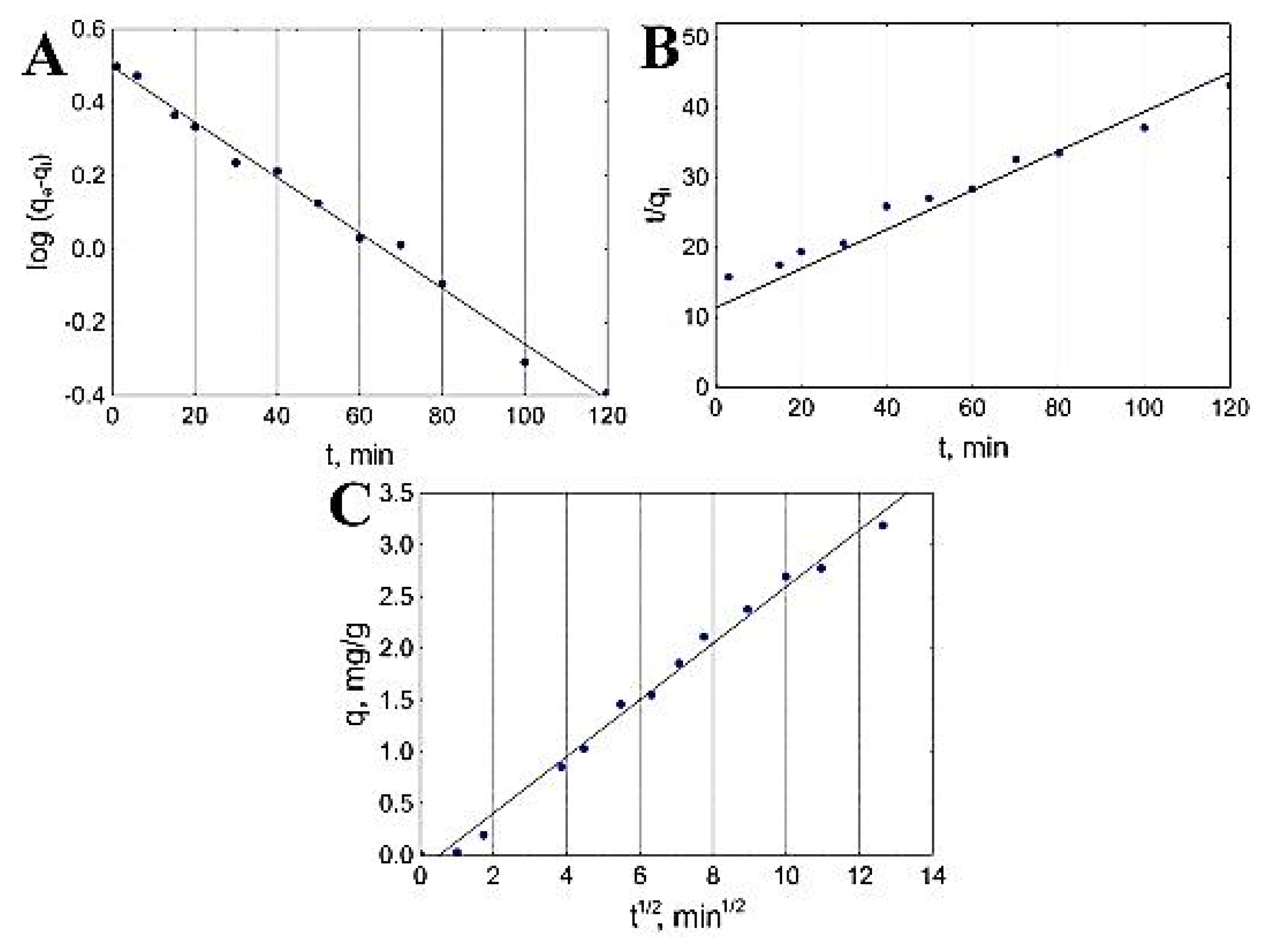
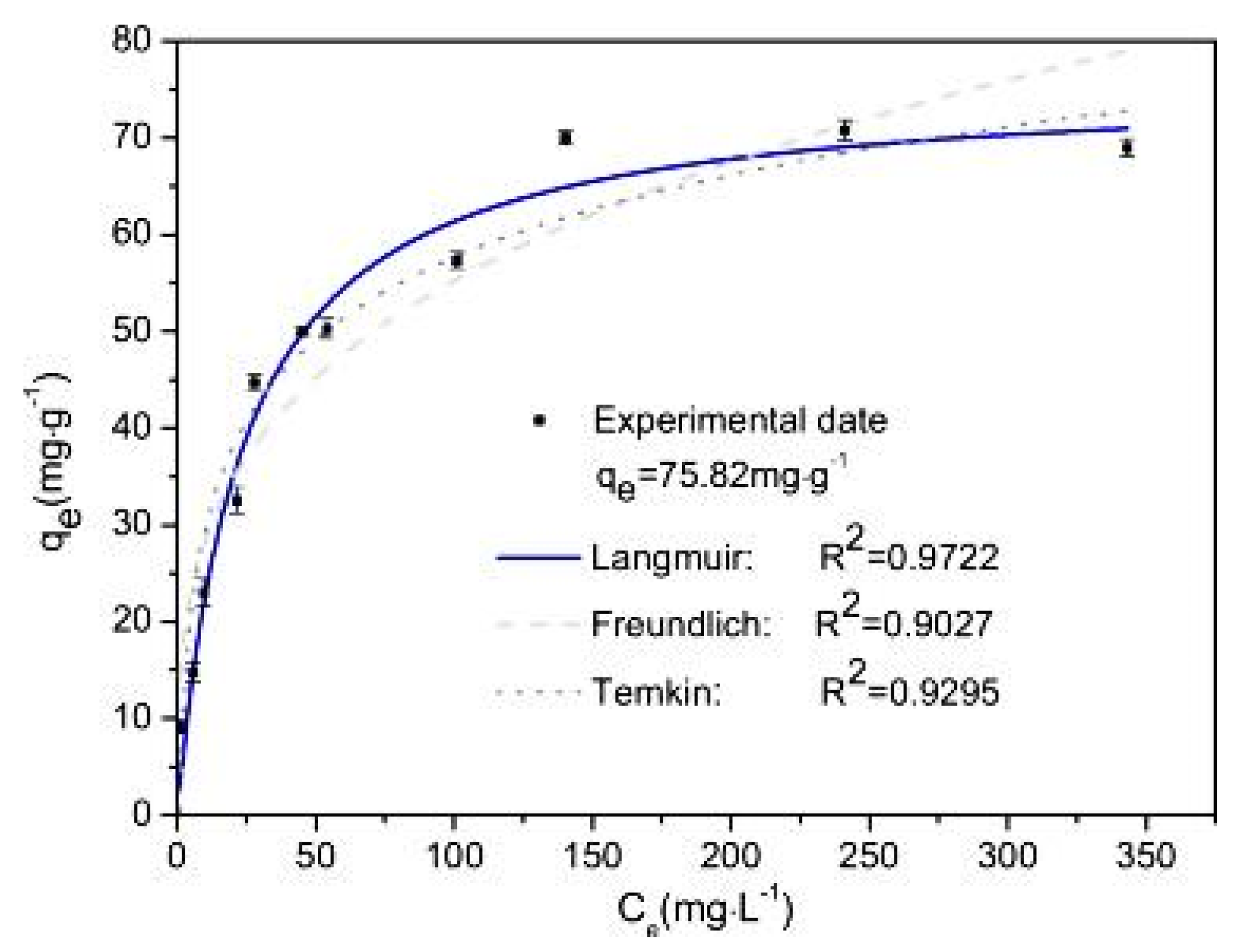
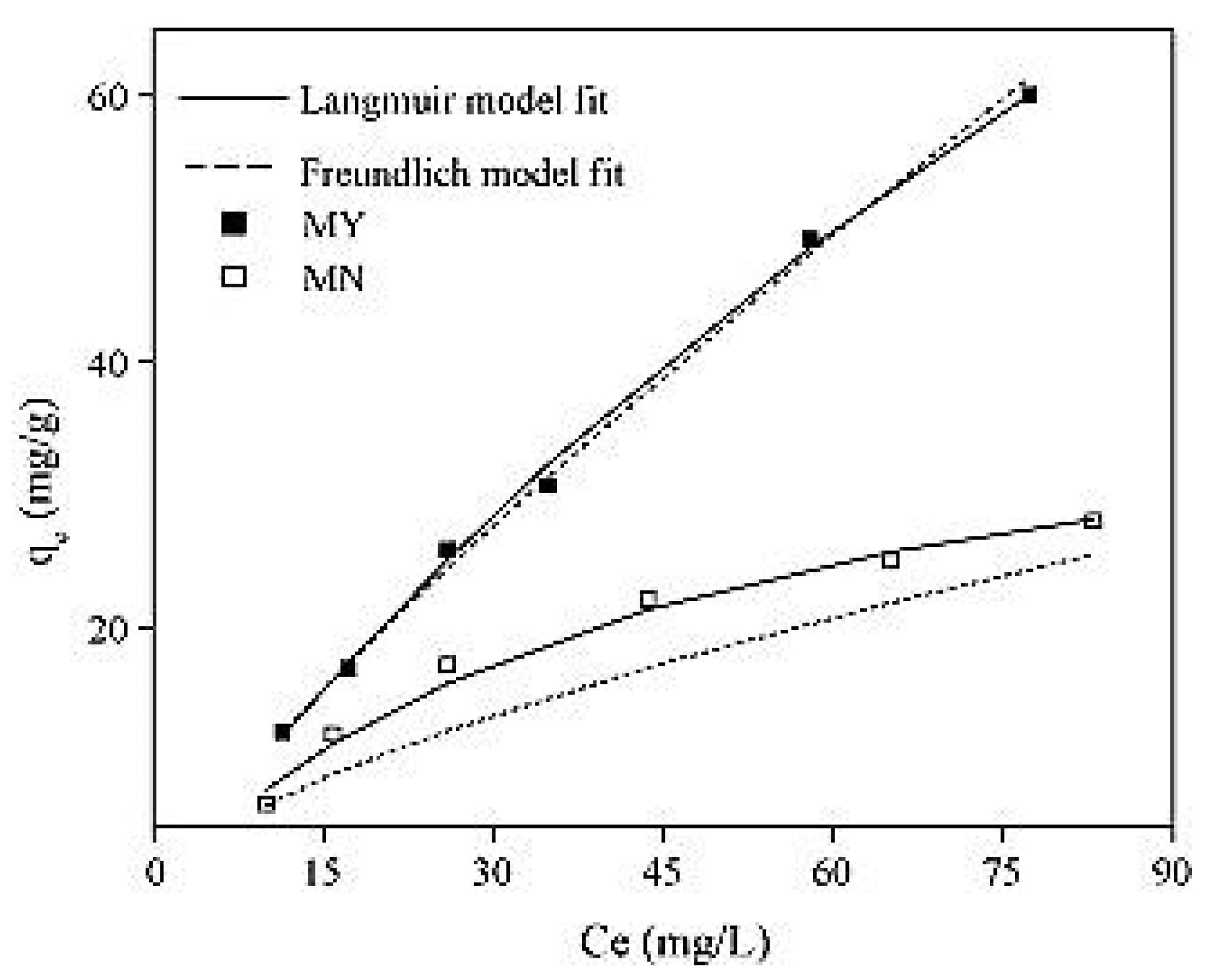
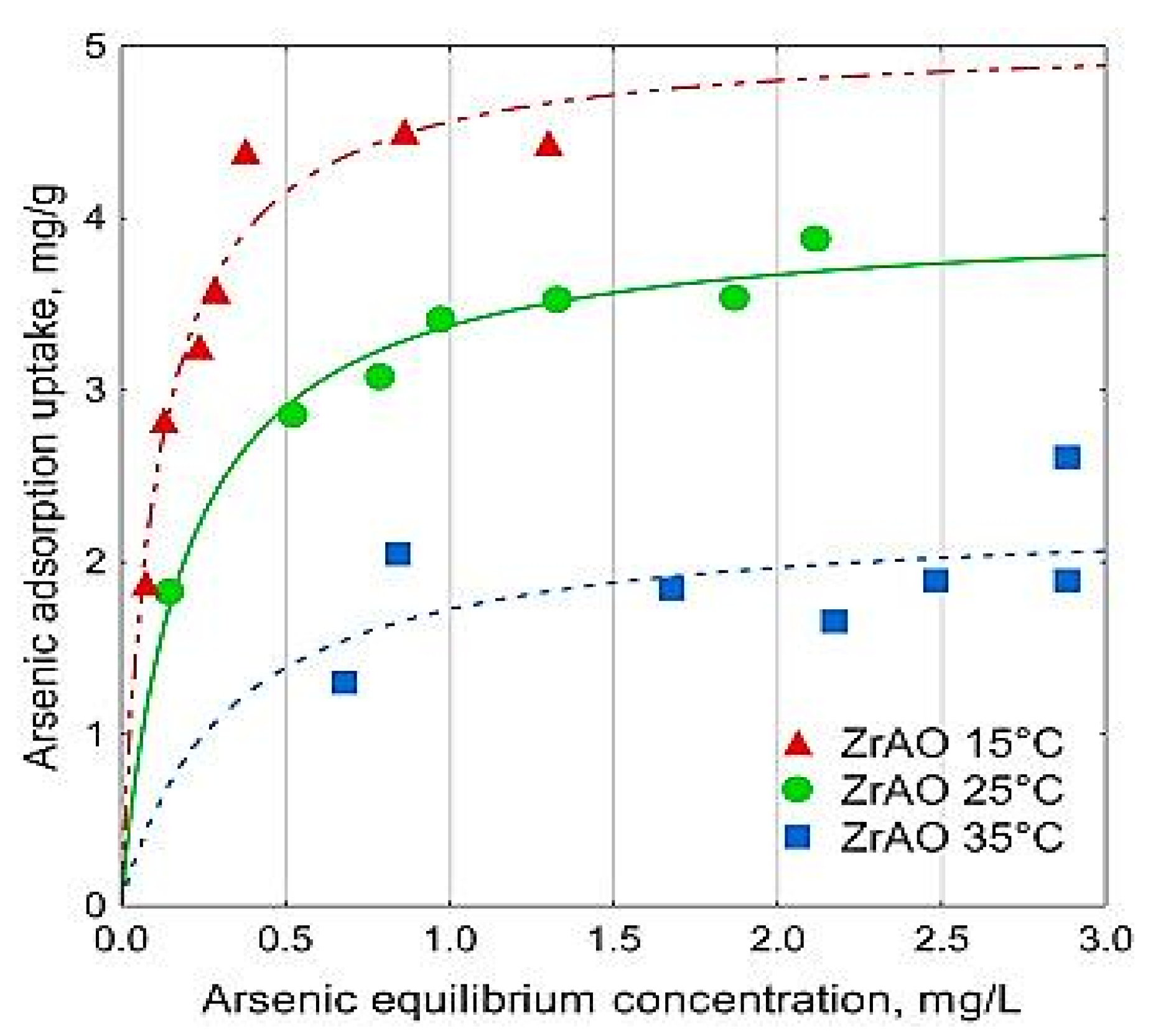
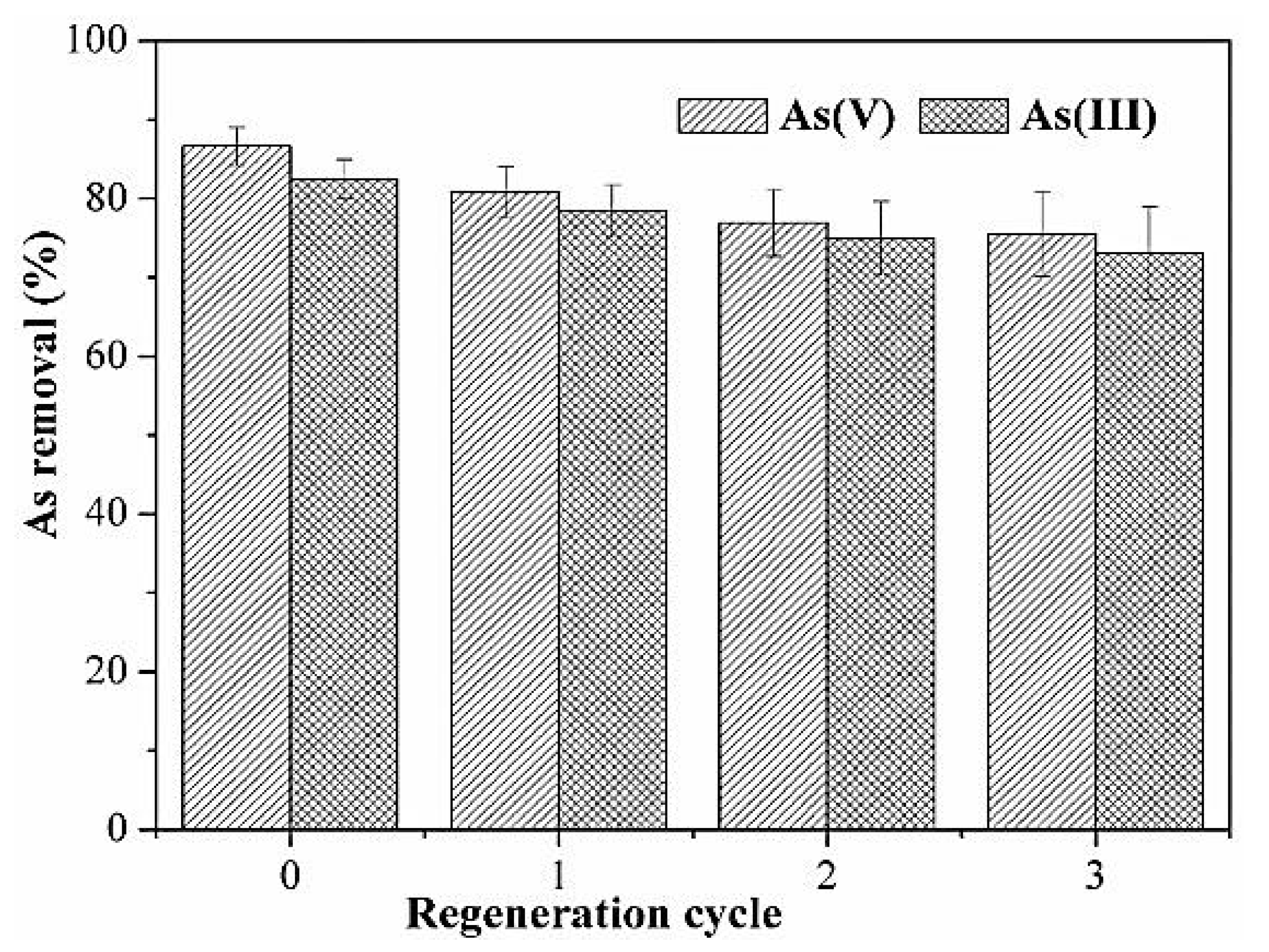
| Adsorbents | Active Groups | Form | References |
|---|---|---|---|
| Fe-Mn-Sac | Manganese dioxide and iron hydroxide | As (III) | [23] |
| Fe-GAC | Iron oxides | As (V) | [24] |
| Zirocnium impregnated AC (ZrAO) | Zirconium | As (V) | [25] |
| Fe3O4-loaded activated | Iron(II,III) oxides | As (V) | [26] |
| IMIGAC | Iron manganese binary oxide | As (III), As (V) | [27] |
| Iron/calcium impregnated AC | Iron/calcium | As (III), As (V) | [28] |
| Fe:Mn-AC | Iron-oxyhydroxides using Mn2+ | As (V) | [29] |
| Adsorbents | Form | Kinetic Model | Qm (mg/g) | Isotherm Model | References |
|---|---|---|---|---|---|
| Fe-Mn-Sac | As (III) | ps2 | 75.82 | Langmuir | [23] |
| Commercial activated carbon F400 | As (V) | ps1 | 2.72 | Langmuir | [25] |
| Zirocnium impregnated AC (ZrAO) | As (V) | ps2 | 3.9 | Langmuir | [25] |
| Granular activated carbon (GAC) | As (V) | ps1 | 1.01 | Freundlich | [24] |
| Fe-GAC | As (V) | ps2 | 1.43 | Freundlich | [24] |
| Fe3O4 loaded activated carbon (MY) | As (V) | ps2 | 204.2 | Freundlich | [26] |
| Iron/calcium-impregnated AC (GL100 | As (III), As (V) | ps2 | 2.985/3.385 | Langmuir | [28] |
| Iron/calcium-impregnated AC (GL200) | As (III), As (V) | ps2 | 2.516/2.807 | Langmuir | [28] |
| Regular mesoporous carbon (XHIT) | As (III), As (V) | ps2 | 1.936/2.013 | Langmuir | [28] |
| Pristine activated carbon (F-400) | As (V) | ps2 | 1.99 | Langmuir | [29] |
| Mn-F400 | As (V) | WM | 1.49 | Langmuir | [29] |
| Fe-F400 | As (V) | ps2 | 3.55 | Langmuir | [29] |
| Fe:Mn- 2mol/L | As (V) | ps2 | 4.96 | Langmuir | [29] |
| δ-MnO2 loaded AC | As (III), As (V) | ps2 | 13.3/12.56 | Langmuir | [46] |
| Limonia acidissima shell AC | As (III) | ps2 | 68.77 | Langmuir | [47] |
| Tamarix leaves AC | As (III) | ps2 | 37.313 | Freundlich | [48] |
| Iron oxide clay-AC | As (V) | ps1 | 5 | Langmuir | [49] |
| F400-SM | As (V) | ps2 | 1.01 | Langmuir | [19] |
| CAZ-SM | As (V) | ps2 | 0.25 | Langmuir | [19] |
| CAP-SM | As (V) | ps2 | 0.167 | Langmuir | [19] |
| F400-M | As (V) | ps2 | 1.25 | Langmuir | [19] |
| CAZ-M | As (V) | ps2 | 0.526 | Langmuir | [19] |
| CAP-M | As (V) | ps2 | 0.37 | Langmuir | [19] |
| As (III) | As (V) | |||||
|---|---|---|---|---|---|---|
| Cycle 1 | Cycle 2 | Cycle 3 | Cycle 1 | Cycle 2 | Cycle 3 | |
| Initial solution (mg/L) | 14.46 | 19.6 | 180.76 | 0.44 | 0.39 | 0.24 |
| Adsorption rate (%) | 0.13 | 1.39 | 1.75 | 16.55 | 13.55 | 12.67 |
| Recovery (%) | 85 | 75 | 73 | − | − | − |
Publisher’s Note: MDPI stays neutral with regard to jurisdictional claims in published maps and institutional affiliations. |
© 2021 by the authors. Licensee MDPI, Basel, Switzerland. This article is an open access article distributed under the terms and conditions of the Creative Commons Attribution (CC BY) license (https://creativecommons.org/licenses/by/4.0/).
Share and Cite
Meez, E.; Tolkou, A.K.; Giannakoudakis, D.A.; Katsoyiannis, I.A.; Kyzas, G.Z. Activated Carbons for Arsenic Removal from Natural Waters and Wastewaters: A Review. Water 2021, 13, 2982. https://doi.org/10.3390/w13212982
Meez E, Tolkou AK, Giannakoudakis DA, Katsoyiannis IA, Kyzas GZ. Activated Carbons for Arsenic Removal from Natural Waters and Wastewaters: A Review. Water. 2021; 13(21):2982. https://doi.org/10.3390/w13212982
Chicago/Turabian StyleMeez, Elie, Athanasia K. Tolkou, Dimitrios A. Giannakoudakis, Ioannis A. Katsoyiannis, and George Z. Kyzas. 2021. "Activated Carbons for Arsenic Removal from Natural Waters and Wastewaters: A Review" Water 13, no. 21: 2982. https://doi.org/10.3390/w13212982
APA StyleMeez, E., Tolkou, A. K., Giannakoudakis, D. A., Katsoyiannis, I. A., & Kyzas, G. Z. (2021). Activated Carbons for Arsenic Removal from Natural Waters and Wastewaters: A Review. Water, 13(21), 2982. https://doi.org/10.3390/w13212982










